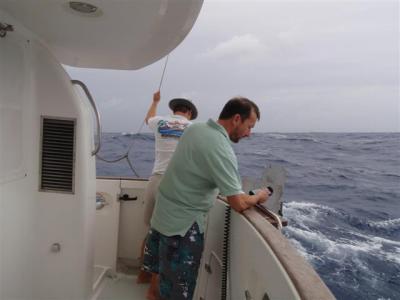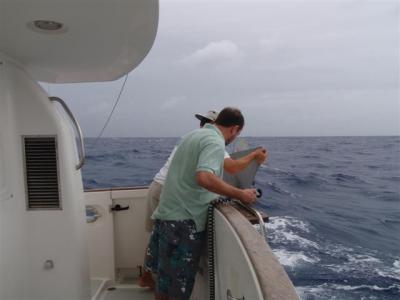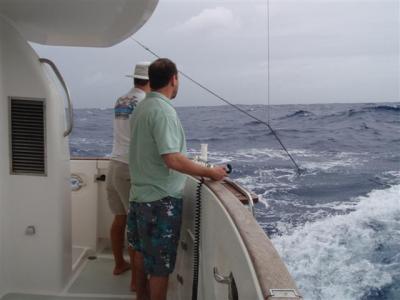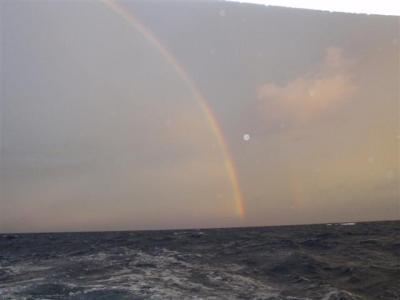Day 9 – 0800 UTC location: 20°22.00N by 32°30.00W and 1087 nm from Las Palmas. Yesterday’s average speed was 5.8 knots at 1500 RPM.
Conditions:
Wind and seas continued to pick up through the night and by morning wind was at 12 16 knots apparent from the pot aft, swells were 5 7 feet and wind waves were 1 2 feet. Unfortunately, the swells were coming from one direction, and the waves from another, so the seas were a bit confused. It was not terrible, but it is certainly no fun, either. And it just got progressively worse all day. Several squalls blew through in the afternoon and night, most bringing very heavy rain and strong wind from erratic directions. The erratic winds weren’t good for the seas, and it seemed each squall made them even more confused. We were rolling pretty darn good, and the seas were once again starting to become reminiscent of the South Pacific. Needless to say, the sky was filled with dark gray clouds and it was gloomy all day. The clouds were so thick that they blocked pretty much all moonlight and it was a dark night. It is definitely getting more humid out.
News:
At 1100, Eric and Colin put out the paravanes. They’d been debating about it all day yesterday. The con for putting them out was mainly that we would slow down. The pro for putting them out was that we could shut off the port active fin stabilizer for a while, which would give us a break from the aggravating noise. We forgot to mention that the starboard side was also starting to make a little bit of noise, too, but we always kept the starboard stabilizer on. One active fin does a pretty good job, roughly damping about 60-70% of the roll that both fins would do. Here is a series of photos of the paravane deployment. The first photo is of Colin using the remote control to get the paravane retrieval line in the proper position to be deployed. Eric is guiding the retrieval line, and tells Colin to stop when the line is in proper position. The second photo is of Eric throwing out the fin. Third photo is of the paravane in the water. We should have had a bit more slack in the retrieval line, but that was easily fixed.



While we were outside dealing with the paravanes, we noticed that the entire boat is coated in a yellowish red dust that is carried by the wind from continental Africa. It is similar to the dust we got in Tunisia. We were relieved when it did start to rain, hoping that it would wash away the dust. Of course, as soon as we had to shut everything up completely because of the rain, it became hot and stuffy inside, so we turned on the generator, ran the AC, and did a load of wash. The timing was great, as we needed to do laundry anyway.
We have been experimenting with the active fin stabilizers on and off throughout the day. As you would expect, it is definitely much smoother with both the paravanes and active fins running simultaneously. We will turn off the active fins for a few hours, until we get to the point where we simply can’t take the rocking anymore. Then we will turn the active fins back on until can’t take the noise anymore, then we turn them back off, and so the cycle goes. The guys have looked at the port stabilizer some to see if they can figure out what the noise is from. The theory is that the mounting of one of the pumps may be loose.
In more minor news, Eric could only hear one of the boats on the radio net, and not too well. And, near sunset, we saw an absolutely beautiful rainbow. The main rainbow was enormous, a perfect arc spreading across the sky. Colin commented that the rainbow is so tall that satellites are probably passing through it. A second rainbow paralleled it on the right side. It was extraordinary. The last photo is near sunset. We thought it looked cool the way the light filtered through the clouds.


Day 10 – 0800 UTC location: 20°02.20’N by 034°49.20’W and 1218 nm from Las Palmas. Yesterday’s average speed was 5.5 knots at 1500 RPM (paravanes deployed).
Conditions:
The weather pattern that started yesterday afternoon has continued all day today. Many squalls have blown through, most bringing wind from a different direction. The rain has come from both sides and back, so at least Kosmos has had an incredibly thorough wash down. The squalls are big enough that we can see them coming on radar. If the sailors were up at this latitude with us, they’d be going crazy with the constant sail changes. In between squalls, the wind is nearly dead. The seas pick up and calm down with each squall, and between the squalls it is about 4 6 foot swells and 3 foot wind waves, and of course, the occasional big roll that knocks us 15 degrees on each side. Needless to say, the overall effect is that the seas have been getting progressively more confused as the day wears on. It was another gray day and black night. We miss the stars.
News:
Speeds have been slower than hoped for the last few days, but this morning they were abysmally slow, down into the 4’s. Fortunately speed improved in the afternoon. We didn’t run the port active fin stabilizers all night. When we turned it on again this afternoon, we found that now that the seas are bigger, the noise is more consistent, and thus is back to being a tolerable white noise. They are working really hard, despite the fact that the paravanes are out. It gets stuffy inside when we have to shut the doors and hatches for the rain.
We e-mailed the sailors and set the radio net for a new channel that hopefully has better propagation. It worked and we were able to talk to them. We have the worst of the weather of everyone, though no one is happy with the weather today. We are by far the most northwest. We also saw a ship on radar, 14 miles away. It is the first vessel we have seen in days.
And a couple blog questions:
Q: Why didn’t you have Nordhavn send you another pump when you were in Gibraltar? A: In retrospect, we should have called Nordhavn first, but it wouldn’t have changed the fact that the real issues were the shipping cost/time frames from the US and indefinite customs delays in Gibraltar.
Q: Did you try looking for a rebuild kit for the Shurflo 5.7 pump?
A: That is a good idea. But, honestly, we doubt it would be stocked in Europe if the pump isn’t stocked, and we still have the hurdles of shipping and customs if we got it from the US. Also the kit may not fix the problem, so getting the actual pump seemed like the only sure way to get our nice water pressure back.
Q: When you were in Mallorca, did Eric stay up all night because he was worried about the storm or because he just couldn’t sleep?
A: There had been a lot happening in the news that day. He was engrossed in the news and fascinated by the weather.

Hi Eric & Christi- Loving and living(in heart and mind) your adventure. I hold a deep desire to follow in your footsteps someday. I was aboard the Coast Guard ice breaker Polar Star from Seattle to Antarctica in the late 80’s and remember the beauty of the open ocean. Thank you for bringing back those memories.
In reference to your stabilizer/hydraulic troubles… Although I am not exactly sure what stabilization system you have, hydraulic systems in general are right up my alley so I hope that I can offer a suggestion that may be helpful.
Hopefully, as you mentioned, it is as simple as a loose pump mount, but don’t let that go on too long as excessive vibration can destroy the best rotating machinery…quickly!!!
Regarding the noisy pump- check fluid condition ie; level, overheating, flow, foaming, aereation, color.
Foaming can be caused from a breakdown of additives. This can be from moisture and overheating.
Overheating may be caused from added restiction in the hydraulic system or your heat exchanger not doing its job. Has the water flow through your heat exchanger changed? What is the heat transfer in degrees from the inlet to the outlet of the heat exchanger?
Aereation can be caused from a leak on the suction side of your system ie: your pump is sucking air. Check for tightness of hoses and lines and the pump housing itself. The actuator fittings need to be verified tight as well. Also if there are any test ports ( they may look like a tire fill valve or quick change air hose connector)on any part of the system with caps missing…replace the sealed cap.
All shut off valves, flanges and fittings need to be checked for there integrity ie; valve stem packing, connections, o-ring seals and gaskets.
Color can change due to moisture in the oil or from overheating or a myriad of other reasons.
Flow-Do you have a way to verify hydraulic oil flow? If so, has it changed?
Filter condition- many of the simply tattle tail differential pressure sensors on top of the filter housings are inaccurate.
Ensure there are no restrictions in the line from the reservoir/accumulator to the pump, also on the tank return.
Check pressure. Is it running at normal operating pressure? If pressure has changed from normal to high there is a restriction ie; pressure control valve out of adjustment, clogged filter, return line restriction. Lower pressure could be caused from pressure control valve out of adjustment, suction line restriction, bypass of oil at pump or at filter housing. Does pump have internal or external bypass valve? Do you have redundant pressure gauges or capability of verifying pressure other than your normal indication?
Is there an accumulator in the system? If so, is the pre-charge pressure correct?
Has the hydraulic oil been changed during your trip? Have you added different oil than original?
Do you have hoses supplying the actuator or return lines to tank? Are the fittings tight? any cracks? leaks?
Have you had to change a hose underway? If so, is the replacement hose compatible with your hydraulic oil? I have seen many hoses fail on the inside due to heat, age and cheap/incompatible hose. They always look like new on the outside!!!
Do the stabilizers operate correctly through there entire stroke? Does the pump noise level change when they are in mid stroke versus bottomed out?
I hope this helps. Do you feel the stabilizers have fallen short of being considered reliable? I realize they have a lot of work to do and you are putting many hours on the system but hydraulic systems such as this need to be bullet proof. Your auto pilot is working the rudder just as frequently and I would venture to say that system has been reliable for you. Has the stabilizer manufacturer been of assistance and reading your blog?
Good Luck, I look forward to your posts.
Bill
Assuming the price is not an issue, would you be more happy having N55 for your journey?
Good advice from Bill